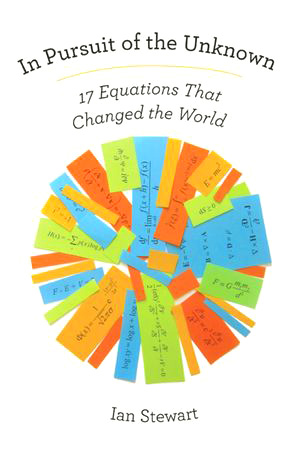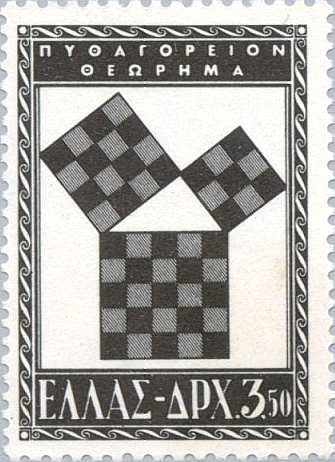What Descartes has to do with C. P. Snow and the second law of thermodynamics.
 When legendary theoretical physicist Stephen Hawking was setting out to release A Brief History of Time,
one of the most influential science books in modern history, his
publishers admonished him that every equation included would halve the
book’s sales. Undeterred, he dared include E = mc², even though
cutting it out would have allegedly sold another 10 million copies. The
anecdote captures the extent of our culture’s distaste for, if not fear
of, equations. And yet, argues mathematician Ian Stewart in In Pursuit of the Unknown: 17 Equations That Changed the World,
equations have held remarkable power in facilitating humanity’s
progress and, as such, call for rudimentary understanding as a form of
our most basic literacy.
When legendary theoretical physicist Stephen Hawking was setting out to release A Brief History of Time,
one of the most influential science books in modern history, his
publishers admonished him that every equation included would halve the
book’s sales. Undeterred, he dared include E = mc², even though
cutting it out would have allegedly sold another 10 million copies. The
anecdote captures the extent of our culture’s distaste for, if not fear
of, equations. And yet, argues mathematician Ian Stewart in In Pursuit of the Unknown: 17 Equations That Changed the World,
equations have held remarkable power in facilitating humanity’s
progress and, as such, call for rudimentary understanding as a form of
our most basic literacy.
Stewart writes:
The power of equations lies in the philosophically difficult correspondence between mathematics, a collective creation of human minds, and an external physical reality. Equations model deep patterns in the outside world. By learning to value equations, and to read the stories they tell, we can uncover vital features of the world around us… This is the story of the ascent of humanity, told in 17 equations.
From how the Pythagorean theorem, which linked geometry and algebra, laid the groundwork of the best current theories of space, time, and gravity to how the Navier-Stokes equation applies
to modeling climate change, Stewart delivers a scientist’s gift in a
storyteller’s package to reveal how these seemingly esoteric equations
are really the foundation for nearly everything we know and use today.

Greek stamp showing Pythagoras's theorem
But the
case for why we should even care about equations — and mathematics, and
science in general — goes back much further. In 1959, physicist and
novelist C. P. Snow lamented — as Jonah Lehrer did half a century later — the tragic divergence of the sciences and humanities in his iconic lecture, The Two Cultures:
A good many times I have been presented at gatherings of people who, by the standards of the traditional culture, are thought highly educated and who have with considerable gusto been expressing their incredulity at the illiteracy of scientists. Once or twice I have been provoked and have asked the company how many of them could describe the Second Law of Thermodynamics. The response was cold: it was also negative. Yet I was asking something which is about the scientific equivalent of: ‘Have you ever read a work of Shakespeare’s?’
Snow later added:
I now believe that if I had asked an even simpler question — such as, What do you mean by mass, or acceleration, which is the scientific equivalent of saying, ‘Can you read?’ — not more than one in ten of the highly educated would have felt that I was speaking the same language. So the great edifice of modern physics goes up, and the majority of the cleverest people in the western world have about as much insight into it as their Neolithic ancestors would have had.
 It
is no coincidence, then, that some the most revolutionary of the
breakthroughs Stewart outlines came from thinkers actively interested in
both the sciences and the humanities. TakeRené Descartes, for instance, who is best remembered for his timeless soundbite, Cogito ergo sum — I think, therefore I am.
But Descartes’ interests, Stewart points out, extended beyond
philosophy and into science and mathematics. In 1639, he observed a
curious numerical pattern in regular solids — what was true of a cube
was also true of a dodecahedron or an icosahedron, for all of which
subtracting from the number of faces the number of edges and then adding
the number of vertices equaled 2. (Try it: A cube has 6 faces, 12
edges, and 8 vertices, so 6 – 12 + 8 = 2.) But Descartes, perhaps
enchanted by philosophy’s grander questions, saw the equation as a minor
curiosity and never published it. Only centuries later mathematicians
recognized it as monumentally important. It eventually resulted in Euler’s formula, which helps explain everything from how enzymes act on cellular DNA to why the motion of the celestial bodies can be chaotic.
It
is no coincidence, then, that some the most revolutionary of the
breakthroughs Stewart outlines came from thinkers actively interested in
both the sciences and the humanities. TakeRené Descartes, for instance, who is best remembered for his timeless soundbite, Cogito ergo sum — I think, therefore I am.
But Descartes’ interests, Stewart points out, extended beyond
philosophy and into science and mathematics. In 1639, he observed a
curious numerical pattern in regular solids — what was true of a cube
was also true of a dodecahedron or an icosahedron, for all of which
subtracting from the number of faces the number of edges and then adding
the number of vertices equaled 2. (Try it: A cube has 6 faces, 12
edges, and 8 vertices, so 6 – 12 + 8 = 2.) But Descartes, perhaps
enchanted by philosophy’s grander questions, saw the equation as a minor
curiosity and never published it. Only centuries later mathematicians
recognized it as monumentally important. It eventually resulted in Euler’s formula, which helps explain everything from how enzymes act on cellular DNA to why the motion of the celestial bodies can be chaotic.
So how did equations begin, anyway? Stewart explains:
An equation derives its power from a simple source. It tells us that two calculations, which appear different, have the same answer. The key symbol is the equals sign, =. The origins of most mathematical symbols are either lost in the mists of antiquity, or are so recent that there is no doubt where they came from. The equals sign is unusual because it dates back more than 450 years, yet we not only know who invented it, we even know why. The inventor was Robert Recorde, in 1557, in The Whetstone of Witte. He used two parallel lines (he used an obsolete word gemowe, meaning ‘twin’) to avoid tedious repetition of the words ‘is equal to’. He chose that symbol because ‘no two things can be more equal’. Recorde chose well. His symbol has remained in use for 450 years.
The original coinage appeared as follows:
To avoide the deiouse repetition of these woordes: is equalle to: I will sette as I doe often in woorke use, a paire of paralleles, or gemowe lines of one lengthe: =, bicause noe .2. thynges, can be moare equalle.
Far from being a mere math primer or trivia aid, In Pursuit of the Unknown is an essential piece of modern literacy, wrapped in an articulate argument for why this kind of knowledge should be precisely that.
Stewart concludes by turning his gaze towards the future, offering a
kind of counter-vision to algo-utopians like Stephen Wolfram and making,
instead, a case for the reliable humanity of the equation:
It is still entirely credible that we might soon find new laws of nature based on discrete, digital structures and systems. The future may consist of algorithms, not equations. But until that day dawns, if ever, our greatest insights into nature’s laws take the form of equations, and we should learn to understand them and appreciate them. Equations have a track record. They really have changed the world — and they will change it again.--by Maria Popova
This article is reprinted with permission from Maria Popova. She is a cultural curator and curious mind at large, who also writes for Wired UK, The Atlantic and Design Observer, and is the founder and editor in chief of Brain Pickings (which offers a free weekly newsletter).
No comments:
Post a Comment